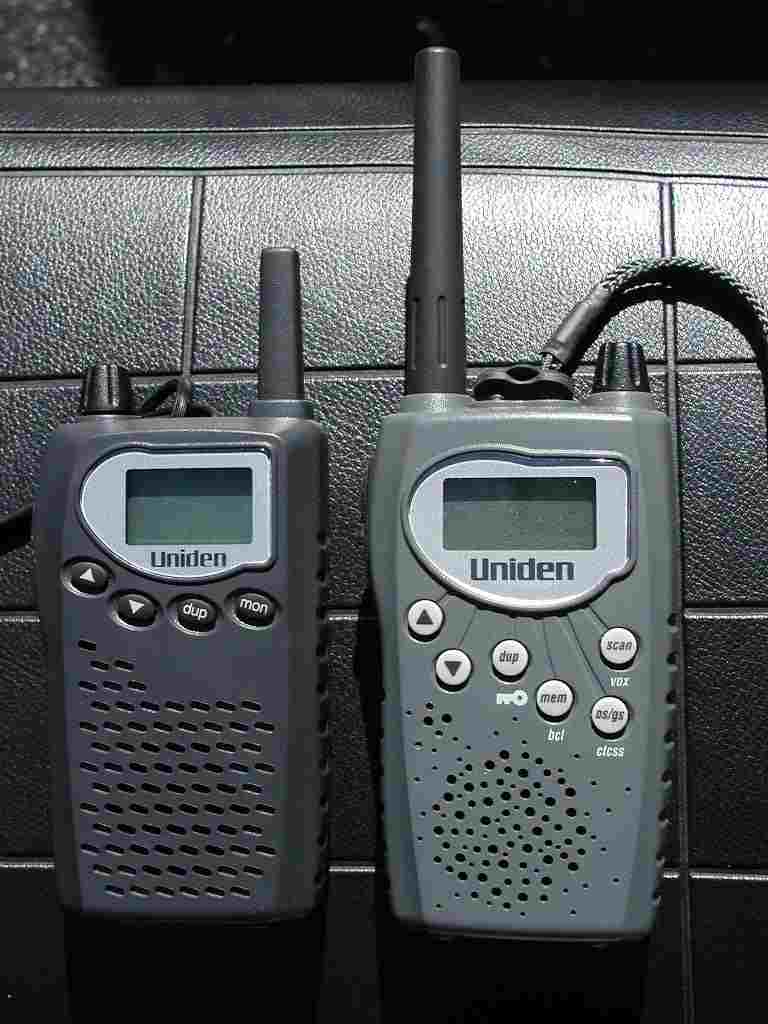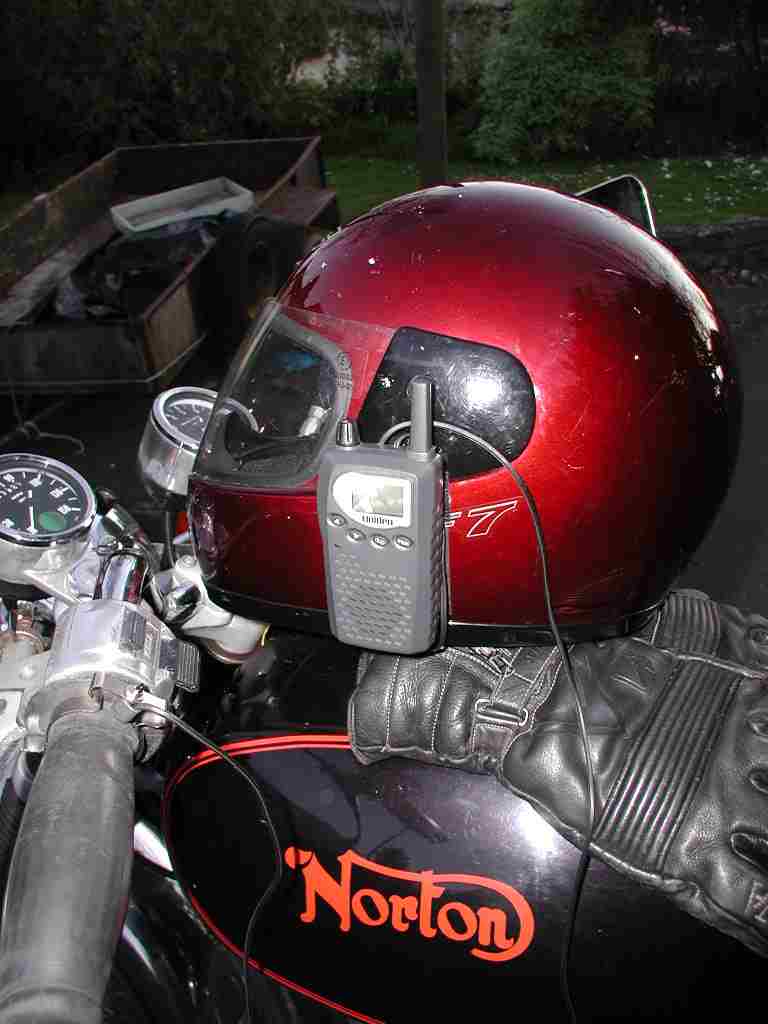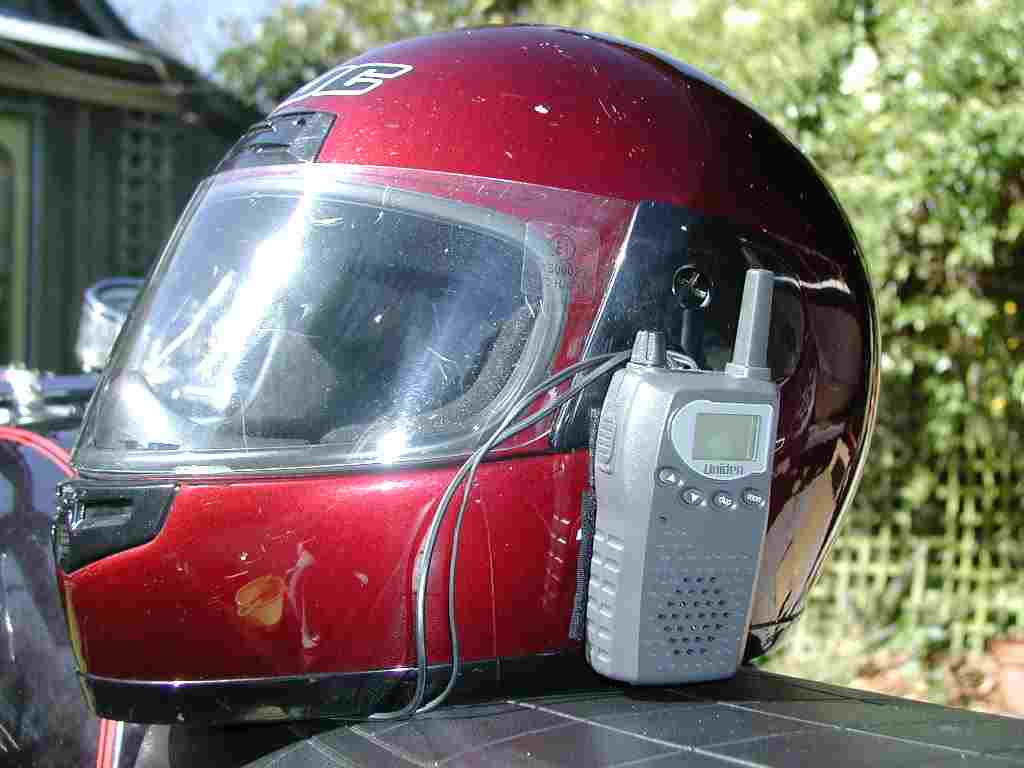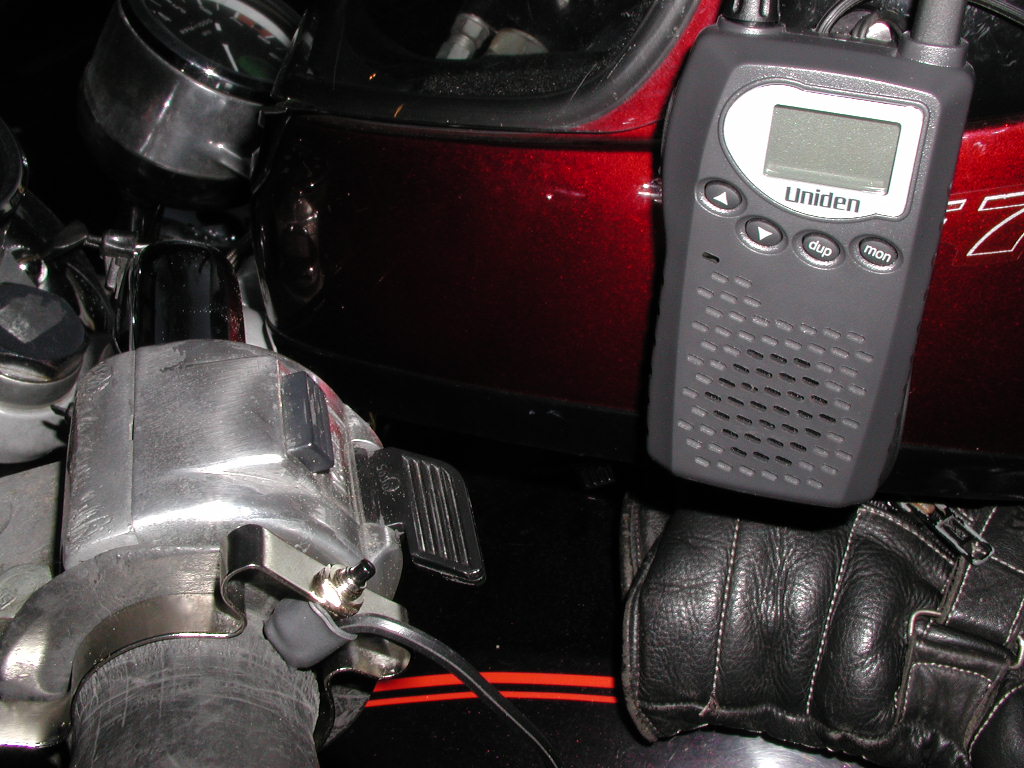
The Uniden UH037 (A low cost approach to Bike to Bike Communications) no longer made

The 'UH037 and the 'UHX042 for size comparison
The '037 is the baby of the Uniden UHF CB radios. It has similar RF performance i.e. receive sensitivity and transmitter power output, despite its smaller size. There are several features that are not available on the "larger" radios such as scanning functions and more importantly an external microphone and earphone jack .These have been left out by the manufacturer in the interest of price cutting to enable production of a less expensive radio. The other most noticeable visible feature is the much smaller antenna . There is a "rule of thumb" in the world of radio communications, "the more wire you have in the sky, the better the signal" hence greater range is available. I feel sure that the range of this Uniden 037 in theory, will be slightly less that the other units with their longer antennas however in practical terms, if you placed an '040/042 against a '037 there are so many uncontrolled variables that can affect the signals in a simple hand held test, that for all intents and purposes there my not be much in it ! The only features I was not quite so keen about was the fact the '037 uses more expensive "AAA" batteries. I guess its the tightwad in me. So shop around when you do buy "AAA" cells and only buy alkaline , as you get more bang-for-your buck with alkaline cells than the cheaper manganese or carbon zinc cells , There are some really good deals in bulk buying of alkaline cells are available from that "Australian based electronics chain store" that is in just about all of New Zealand cities (AAA cells for under a $1 each!)
WIND NOISE : Here are some of the variables that affect this systems operation. Some helmets produce more wind noise than others , also some motorcycles produce a lot of wind turbulence. My '73 850cc Norton interstate is a shocker for wind noise and turbulence, this is due my bolt upright riding posture and lack of streamlining (Mine and the bikes). It produces a lot of wind noise as do most non fairing motorcycles eg old British and American styles , However my BMW K100RS with its streamline fairing and wind deflection screen produces a lot less wind noise around the helmet, as most wind passes over the top there is much less wind buffeting around the neck region. hence there is much less background "noise" on my voice transmissions for the same road speed . I dare say a lot of modern Japanese and European machines with fairings, will be in the less turbulent "BMW" category. Wind turbulence is of course related proportionally to speed in fact it is a cubic relationship, that why it takes so much more power to go significantly faster! roughly ..to double the speed requires 9 times more energy! A snug fitting scarf or neck Tube reduces helmet wind noise, If you can hear the improvement then your riding buddy at the end of the radio will to!. You can move the position of the microphone. Some riders have found that sliding it through the helmet lining directly in front of the mouth helps a lot (difficult on some types of helmet). So you can see ,I cant tell you whether with your setup, you can go at 100 Mph (and still have crystal clear comms) realistically, some how I think not , but if you understand what contributes to wind noise, interfering with your communications, you can experiment quite a bit to improve the situation . I will, however put my neck out and say that I and another friend Have used them at speeds of 130-140 Kph and the speech was still OK, not High Fidelity. (due to increase in local wind noise around the helmet as I did not have a scarf on or and earplug in the unused ear. ) but if you understand what contributes to wind noise, interfering with your communications, you can experiment quite a bit to improve the situation To get the best "at speed" performance , make sure the earspeakers are correctly positioned over the ears ,move them around over the ears until they are in the "loudest" position ..
I have connected the PHS brand headset and PTT permanently to the '037 Uniden such that they cannot be disconnected from the radio. This means you can no longer use it as a walkie talkie like the '040 and '042 by unplugging the headsets. This is the price you pay for utilising the less expensive radio . This in realty, may not prove such a handicap as I have found that the small uniden perform very well when velcroed to the side of the users helmet, giving good clear reception all round when compared to being stuffed into a pocket of a leather jacket!


Ptt handlebar and helmet '037 Uniden'037 Velcroed to side of helmet
The versatile PHS headset supplied with the '040 and '042 radios, enables the wearer to unplug the radios from the from the helmet, dismount the bike and leave the comms equipment behind. With this set up and the 037 attached to the helmet, or in your jacket pocket , you will have to unclip the PTT button from the handle bar before moving away from your mount.

Handlebar PTT and Radio
USE OF RADIO The radio is turned on and the volume adjusted to a predetermined level of comfort. Switch on and the rotate volume control about a quarter turn (90 degrees), this will be loud enough! Make sure "DUP" is not displayed. Set the radio channel via the up-down buttons to be the same on all radios. The default channel is always CH 5 when switch on , unlike the 040/042, this radio doesn't remember the last channel used before it was switched off. Please do not use ch 11 for routine communications, as this is the emergency calling channel. The PTT thumb-switch is attached/clipped to the clutch side handle bar and placed in a position where it can be easily operated by the gloved Finger or thumb in a comfortable riding position.
Note for Australian users:
I suggest you do not to use the first 8 channels in simplex mode , unless you intend to access a repeater (in which case you do want to use duplex mode, it is handy to leave this enabled on these channels). Ch 11 in Australia is no longer the emergency calling channel, it is now a backup and the real emergency channel is Ch5 and its associated repeater uplink Ch 35. (channels 31 to 38 are best not to be used unless your accessing a repeater through duplex mode). 22 and 23 are now reserved in Australia for data and telemetry, just to add to the confusion :)
No! it is not waterproof! I am looking at a simple way of enabling this, without going to great expense and trouble. I am sure a firm fitting thick walled plastic bag pulled over the radio from the bottom with the Velcro hooks firmly stuck to the back of the plastic bag, the top sealed by folding over and fixed securely , will enable this. I will keep you posted.This set-up uses the usual combination headset and boom microphone that is held in the users helmet by Velcro hooks on the rear of the headset. Position the earpiece of the headset in the helmet slightly above the ear instead of centrally over it, or surprisingly enough the soft earlobe area will get uncomfortable from even slight continuous pressure. Headset placement is best done using a piece of cardboard or paper 6" by 3"held between the "furry" lining of the helmet and the Velcro hook backing of the headset. Position the headset into the correct comfortable position then pull out the paper/cardboard and allow the Velcro hooks to attach themselves tenaciously to the "furry" lining in the helmet!
Battery life: Like everything, it depends how hard you flog it along . The batteries in my demonstration units appear to last for weeks! Remember, it is transmitting that uses most of the battery power, receiving doesn't use much at all. I suspect with intermittent use which allows the batteries to bounce back somewhat, you could easily get up to a couple of weeks out of them . Remember "AAA" cells are smaller in volume hence contain less energy than their "AA" counterparts, they will not last as long.
Radio range is very dependant on where you place the radio. The more you shield the radio up against your body ,the more your internal blubber will soak up the signals and there will be less to radiate out into the air and towards the other riders. Having it on your person will also cause a shielding effect of your body in certain directions, that will limit range. This could be down to as little as 100 m!! Remember this radio has a shorter antenna than the others so radio placement for optimum range is even more important with the '037. The optimum place to have the radio is attached to the side of your helmet as in the picture, up out in the clear, this gives the best range. I have found that attached to the fairing of your bike, if it has one, with the antenna vertical if possible is a good spot, or clipped to the brake, clutch or other cables at the front of your machine, gives good range as well. Make sure the radio is adequately attached to the bike by a safety line. When mounted to the side of the helmet, the PTT cable can be bought up and through the top of the visor for extra security. That way, if the Velcro ever lets go then it is held firm by the PTT cable passing through and under the top of the visor . If the radio meets the road at 100 Kph +, its life chances are very slim and that particular fault is not covered under the radios' warranty!
Radio range will also depend on the terrain you are riding through. Built up suburban or city centre can be down to one or two blocks, steep rolling country my be only up to a kilometre, but out on the open plains with the radios in the optimum place on both communicating 'bikes", you may get up to three Kms+. Radio range, as with all radios is very much dependant on the antenna efficiency . If you used proper externally mounted UHF CB whip antennas i.e. 5/8 or similar connected by coaxial cable to the radio, you could quite conceivably treble the operating range compared to the '037 short stumpy loaded antenna.
Remember that UHF CB is a shared band and there may be other users on the same channels as you . Be courteous and if you explain you are on a motorcycle and cant change channel without great difficulty they will understand, in fact you may be quite a novelty! Base station UHF CB radios have a much extended range compared to a mobile and could be very useful to you, to relay a message to a "lost" motorcycle buddy who is out of your range!
Want to go back to Motorcycle communications? ...... click here!
Contact:
Pinfold Health Services Ltd., 1172 Arawa St. ,Rotorua , New Zealand ph +64-7-3488850 fax +64-7-3486555 pinfold@xtra.co.nz